- How we help you
Freight Focus
Your source for logistics knowledge and market updates
Welcome to This Week in Freight, your go-to source for the latest haulage and road freight news and advice in the UK.
Choosing the right truck for your fleet just got easier. This week’s leading analysis breaks down the best truck brands for UK transport businesses in 2025, comparing reliability, servicing coverage, safety tech and whole-life costs — giving operators a clear view of what truly performs on UK roads.
We also take a deep dive into ISO accreditations and how they’re becoming a key differentiator in winning bigger, better, and more sustainable contracts across the industry.
And in London, new data confirms that tough HGV visibility rules are working — with sharp drops in serious collisions involving vulnerable road users.
Alongside the big stories, we’re covering major sustainability developments across Europe, from investment in heavy-duty charging corridors to new long-range electric trucks and biomethane breakthroughs. Plus, practical guides on bulk haulage, EU licence reforms, AI adoption in logistics, and the latest industry trials from DPD and Mercedes.
Let’s get into the week’s biggest shifts shaping UK and EU road transport.
🛣️ UK’s best trucks for 2025
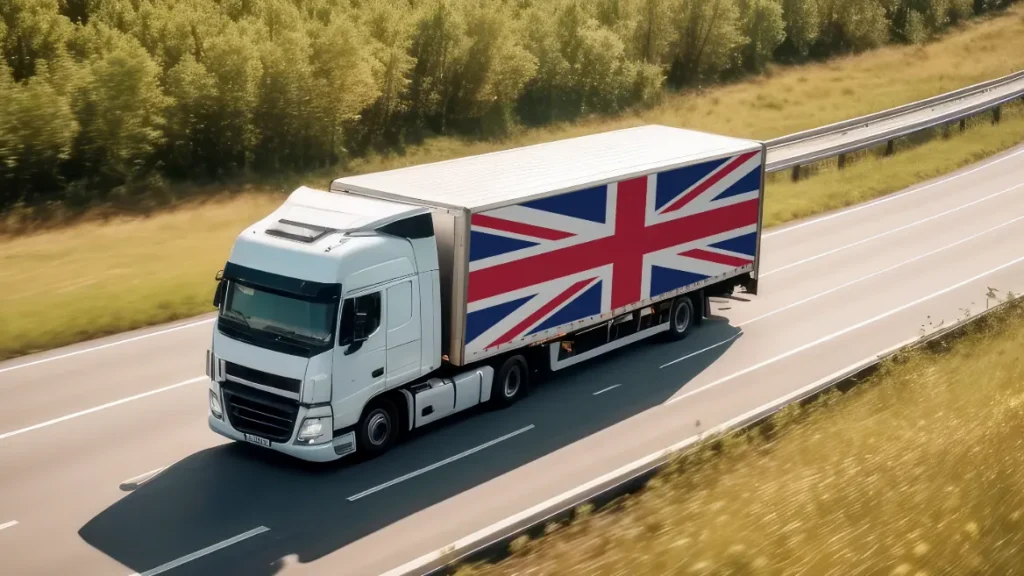
Choosing the right truck brand shapes uptime, running cost and fleet performance — and the gaps between manufacturers are widening.
Our new guide breaks down how Scania, Volvo, Mercedes, DAF and MAN stack up for fuel economy, servicing coverage, safety tech and driver comfort.
It also explains which brands suit long-haul, regional or vocational work, plus the latest on diesel, electric and gas powertrains. A must-read for anyone planning their 2025 fleet strategy.
→ See how the major brands compare.
🏙️ Safer streets thanks to London’s HGV rules

New TfL collision data released for Road Safety Week shows a sharp drop in serious injuries involving HGVs and vulnerable road users since London introduced the Direct Vision Standard.
The figures confirm that improved cab visibility and blind-spot elimination are preventing the most severe incidents. With mandatory permits, roadside checks and upgraded safety systems now in force, London’s model is influencing EU design rules too.
→ Read the full findings behind the safety gains.
🏅 ISO basics for UK operators

Winning contracts increasingly depends on proving reliability — and ISO accreditations are becoming the benchmark.
In our new guide, we explain how ISO 9001, 14001, 45001, 27001, 39001 and more help hauliers cut risk, improve safety, strengthen sustainability reporting and meet client expectations.
It also covers costs, timelines, audits and how ISO compares with FORS and DVSA Earned Recognition, giving operators a clear path to certification.
→ Get the full breakdown on key ISO standards.
Also worth a read
- ♻️ Here’s a practical guide to walking floor trailers, showing how operators can expand into bulk and waste haulage while staying compliant and safe.
- 🇪🇺 New EU driving-licence reforms will reshape recruitment, minimum ages and cross-border enforcement for hauliers by 2029.
- 🚧 Humber Bridge’s new ANPR tolling system has been pushed to February 2026, delaying fee increases but promising smoother traffic once live.
- 🎖️ MoD examiners are being drafted in to cut HGV test delays, adding thousands of extra tests and easing pressure on vocational test centres.
- 🚚 Mercedes’ new “Safety Truck” shows how advanced detection, braking and fatigue-monitoring tech is becoming a direct driver of fleet profitability.
- 🤖 New research shows most fleet managers believe AI will boost efficiency and cut emissions, with adoption accelerating across the industry.
Sustainability updates
From new charging corridors to cleaner truck technology, here’s what’s driving the shift towards lower-carbon haulage right now.
- ♻️ A new EU deal paves the way for 44-tonne zero-emission trucks in cross-border operations, giving operators more payload flexibility as part of wider Weights & Dimensions reforms.
- 🔌 The EU is investing €600m to build megawatt-class charging corridors and hydrogen stations across major freight routes, accelerating long-haul decarbonisation.
- 🌱 IVECO’s S-Way CNG has set a new benchmark by travelling over 1,000 km on a single refill, showcasing biomethane as a viable low-carbon alternative for long-haul.
- ⚡ Renault Trucks has unveiled new electric models spanning 12-tonne city trucks to 600-km long-haul tractors, expanding zero-emission options across all segments.
- 🚚 DPD is beginning a long-term trial of the Mercedes-Benz eActros 300 lowliner to understand real-world eHGV performance on double-deck trailer routes.
- 🏴 Zemo Partnership will lead a £1m Welsh Government programme to fast-track commercial vehicle decarbonisation through real-world fleet collaboration.
Find reliable carriers and cut your costs with Haulage Exchange
Sign upChoosing the right truck brands for your fleet shapes cost, reliability, and how your business performs on busy UK roads. A strong truck manufacturer helps you control downtime, support drivers, and stay ahead of new transport rules.
In this guide, we’ll compare the main lorry manufacturers operating in the UK and explain how each one fits different transport operations. We’ll also share clear guidance on cost, servicing, powertrains, and what to check before choosing a model for long-term use.
What we’ll cover
Fleets, bookings, subcontractors, compliance & payments.
Book a demo
With HX, you can manage them all in one place.What matters when choosing truck brands in the UK
The right truck brand supports your daily work, not just your long-term plans.
Operators look at servicing coverage, running cost, safety, and compliance before committing to any model.
Uptime and servicing
Uptime has a direct effect on customer commitments. A good support network helps you avoid delays, missed slots, and lost revenue.
When deciding between truck brands, you should check:
- Distance to approved workshops
- Parts availability
- Breakdown response
- Access to night or weekend servicing
Reliable support from the lorry manufacturer also helps you maintain a strong compliance record during DVSA inspections.
Fuel and running cost
Fuel remains the biggest pressure on budgets. Even small improvements matter over the life of a vehicle.
When deciding between lorry brands and models, you should look at:
- Real-world diesel performance
- Tyre choice
- Drivetrain efficiency
- Weight
- Aerodynamics
Fuel also links to emissions. Many fleets track their environmental footprint, which is why HGV carbon output now influences buying decisions for long-term contracts.
Driver comfort and safety
Drivers perform better when they work in a comfortable cab. Good layouts reduce fatigue, and stable handling builds confidence during long shifts.
Safety systems add another layer of protection. Modern ADAS tools help drivers avoid hazards, stay alert in traffic, and handle sudden events on busy roads.
Compliance
Compliance rules affect everything from access to city centres to contract requirements. Trucks that meet these rules early help fleets avoid penalties and save time.
When deciding between lorry manufacturers, you should consider:
- Euro 6(e) standards
- ULEZ access
- Conspicuity markings and safety visibility rules
- Future emissions targets
Some also review how different models affect their record under the operator licence, especially when managing multiple depots.
Costs play a part too, so topics like HGV road tax and long-term budgeting often shape the final decision.
The leading truck brands in the UK and where they fit best
Choose the badge that fits the job, not the marketing line.
Below is a practical look at how each major truck manufacturer performs in real UK operations, so you can match strengths to the work you actually run.
Scania
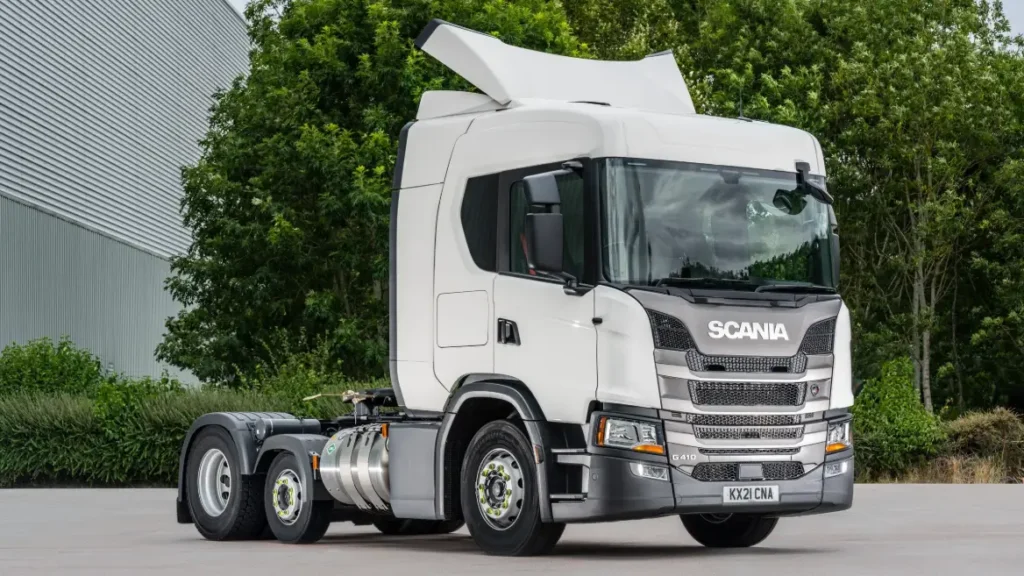
Scania is known for fuel-efficient long-haul performance. It suits operators who run high-mileage motorway work or predictable trunking routes.
Drivers value Scania for comfort and visibility. Both help reduce fatigue during extended shifts.
Scania’s aerodynamic cabs and predictive systems support strong fleet fuel efficiency, which helps cut long-term running cost.
Volvo Trucks
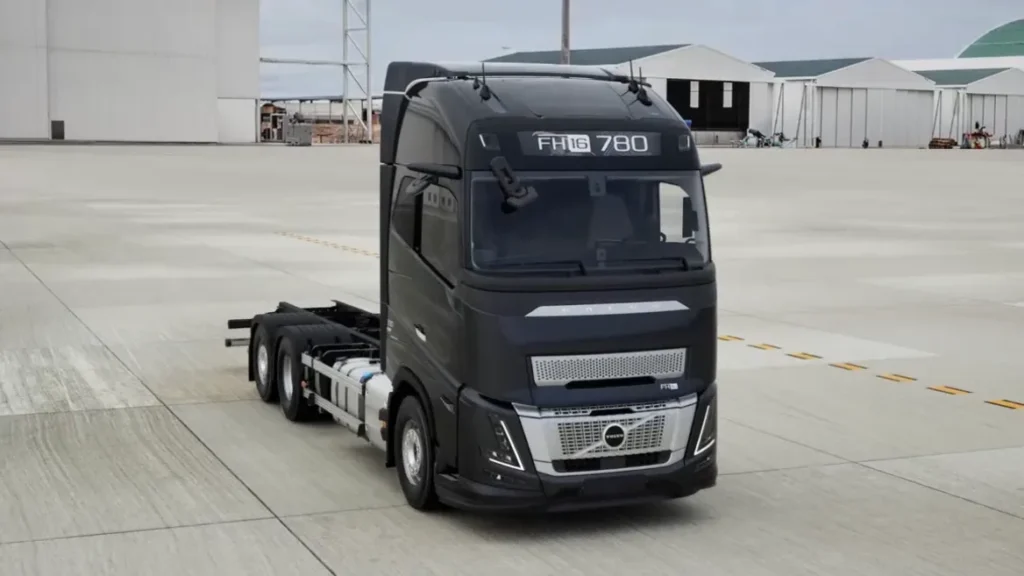
Volvo offers a balanced range of diesel, gas, and electric models. The FH covers long-haul work, while the FE and FM ranges suit regional and urban deliveries.
Safety tech is a standout feature. Volvo’s tools support drivers in traffic, on tight corners, and in low-visibility conditions. This makes it a common choice for fleets focusing on safety performance.
Mercedes-Benz Trucks
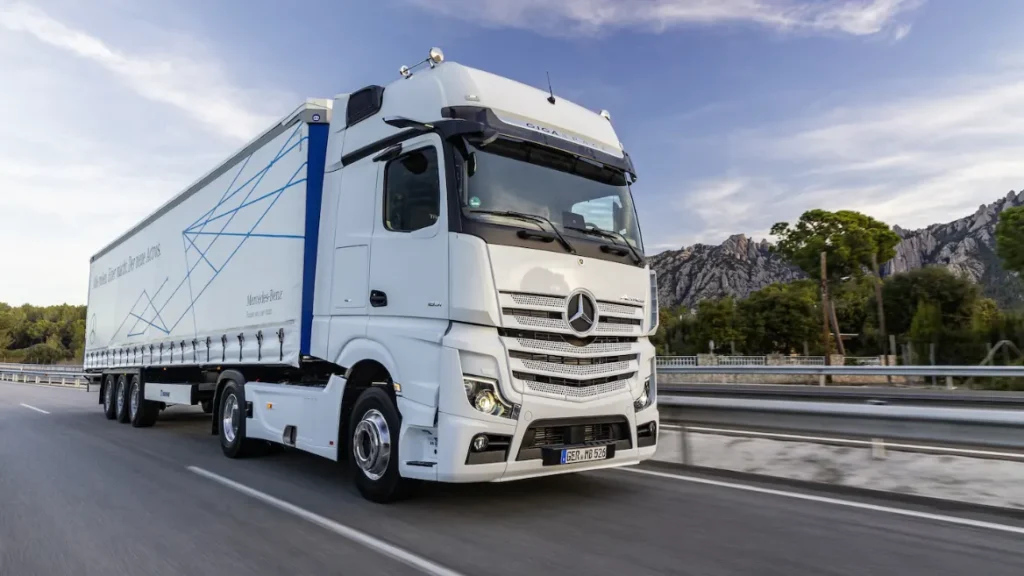
Mercedes works well in cities and busy regional areas. Its cab layouts offer clear visibility, and its safety systems help drivers manage hazards in tight urban streets.
The eActros supports fleets running short delivery routes with depot charging. Operators that handle multi-stop deliveries or city contracts often prefer Mercedes for its comfort and predictable servicing.
DAF
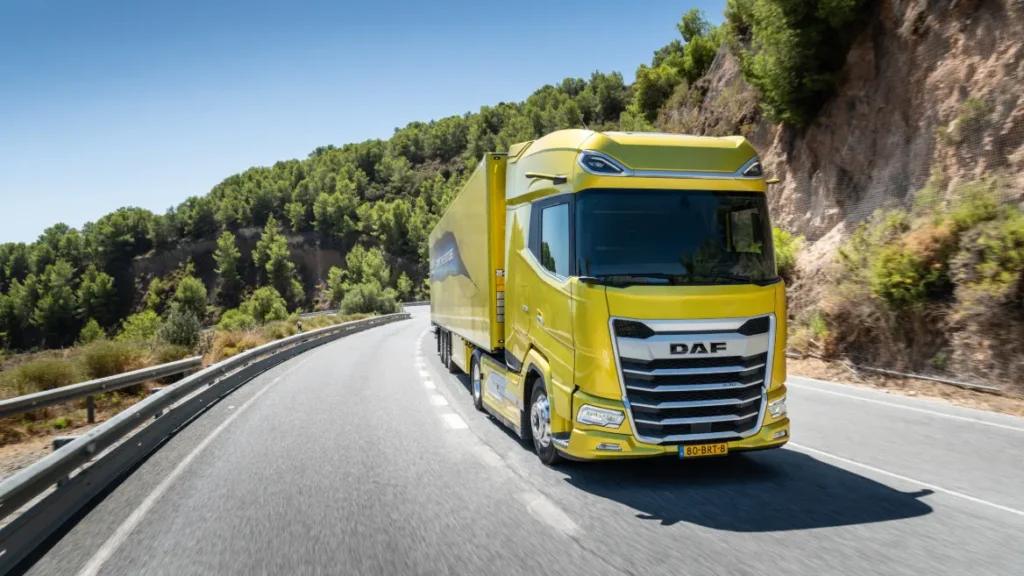
DAF offers one of the strongest servicing networks in the UK. This matters for operators with depots in different regions or fleets working across multiple counties.
DAF suits general haulage, regional distribution, and multi-driver operations. Its cabs offer simple layouts that work well for varied use.
MAN
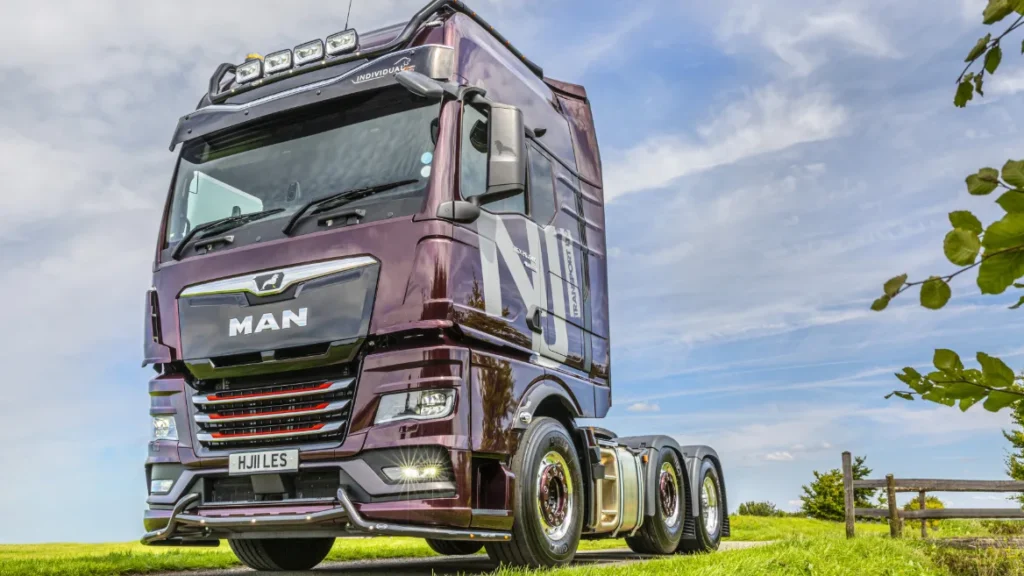
MAN suits fleets running mixed operations. The TGX and TGM ranges offer comfortable cab layouts and predictable fuel use.
MAN supports a wide range of body types, which makes it useful for construction, waste, tanker, and regional distribution work. This flexibility helps operators that run mixed-duty schedules.
Matching truck types to UK transport operations
Selecting the right model matters as much as selecting the right truck brand.
UK fleets rely on three main truck types to cover long-haul, regional, and vocational work.
Tractor units (4×2 and 6×2)
Tractor units handle the heaviest loads in UK haulage. They support 44-tonne operations under lorry size regulations and work best for trunking, container movements, pallet networks, and supermarket deliveries.
Rigid trucks (7.5t to 26t)
Rigid trucks support regional deliveries, municipal duties, and food service work. Many new drivers start with these vehicles as part of their path to become a HGV driver, especially in urban and multi-drop roles.
Vocational trucks
Vocational operations rely on specialist chassis for tippers, mixers, waste vehicles, and recovery trucks. These vehicles handle varied body types and higher stress levels.
Discussions about future regulations and combinations often reference longer heavier vehicles (LHVs), especially for vocational roles with specialist payload demands.
Powertrains: diesel, gas, BEV and alternative fuels
Powertrain choice shapes your fuel strategy and future planning. Each option supports different types of UK routes.
Diesel
Diesel remains dominant for long-distance work because of range and reliability. Many fleets now use compatible renewable blends such as HVO biofuel to reduce emissions while keeping existing routes unchanged.
Electric
Electric trucks work well on predictable urban and regional routes. Depot charging fits these patterns because the truck returns to base after each shift.
Electric models run quietly, which suits night-time delivery windows.
Gas and hybrid
Gas trucks work well on fixed routes with access to refuelling points. They offer lower emissions for operators running closed-loop deliveries.
Hybrids serve a small part of the market, mostly for urban operations. Availability varies widely by truck brand.
Future alternatives
Hydrogen development continues, and test units appear more often across Europe. These models could suit heavier long-distance work in the future.
Sustainability planning in the sector aligns with long-term frameworks such as EBMPS, which guide operators on environmental targets and fleet transition planning.

Operating costs and lifecycle value
Operating cost shapes long-term fleet decisions. It affects fuel spend, repair planning, driver satisfaction, and resale value.
Fuel use and long-term running cost
Fuel performance differs by model and route type. Tractor units covering long-haul work show the clearest gaps in mpg. Even small improvements matter when trucks run hundreds of miles each day.
Fleets replacing older or used HGVs usually gain improved fuel returns, cleaner emissions, and more predictable servicing patterns. These gains support better planning for contracts that demand tight delivery windows or strong environmental performance.
Consistent fuel performance also stabilises margins in sectors that hold seasonal fluctuations or operate under fixed-rate agreements.
Maintenance and downtime
Reliable maintenance support helps fleets control downtime and avoid unexpected delays. Operators look for dependable workshop coverage, good parts availability, and predictable repair times.
Telematics helps here. Many fleets use connected data to plan inspections, track component wear, and monitor engine performance. These tools support better fleet management, especially when operating mixed fleets across several depots.
Good support also protects drivers, who rely on consistent vehicle performance to complete their shifts safely and without disruption.
Warranty and resale
Warranties protect operators from unexpected mechanical costs. Some extend them across driveline or full-vehicle coverage to keep budgets stable during slower periods.
Resale value shapes long-term cost. Higher-value truck brands help operators recover more when selling or trading in older models at the end of a contract.
Finance agreements also influence planning. Operators often review warranty coverage, residual value, and length of ownership when securing HGV finance, especially for fleets that refresh vehicles every few years.
A simple process to shortlist the right truck brands
Choosing the right vehicle starts with understanding how each model fits the work you handle. This simple process helps operators compare options clearly and make informed decisions.
Step 1: Match routes to vehicle types
Your main route structure shapes your buying decisions. Long-distance fleets need stable mpg and driver comfort. Regional fleets need flexibility. Vocational fleets need durable chassis that handle higher stress and site access.
Understanding route patterns helps operators avoid mismatched vehicles that cost more to run or maintain.
Step 2: Compare whole-life cost
Whole-life cost includes fuel performance, maintenance, warranty, and resale value. This view gives a clearer picture than relying on purchase price alone.
Analysing these costs together helps operators build stable budgets and avoid surprises later in a truck’s lifecycle.
Step 3: Gather driver and workshop feedback
Drivers offer real insights on comfort, handling, and fatigue. Workshop teams understand servicing patterns, part availability, and long-term reliability trends.
Collecting feedback from both groups gives a more complete view of how each model performs across daily operations.
Step 4: Trial before buying
Most truck brands offer demo vehicles. Testing them on real routes helps you compare mpg, comfort, visibility, and drivability.
These trials highlight differences that don’t always show up in spec sheets or brochures.
Step 5: Check compliance fit
Compliance influences long-term performance. Trucks must support emissions rules, safety requirements, and reliable maintenance records.
This is where reliable servicing helps fleets stay on track during DVSA inspections, as well as new visibility and emissions rules across major cities.
Final thoughts
Choosing the right truck brand helps fleets protect uptime, manage fuel spend, and improve the driving experience. The best options balance reliability, comfort, and predictable servicing. Each lorry manufacturer offers something different, so the right choice depends on your routes, the type of work you handle, and your long-term plans.
By reviewing servicing coverage, comparing whole-life cost, and trialling models on real routes, operators can choose truck types that support stable margins and strong performance across the year.
A structured approach makes the decision easier, especially as technology, emissions expectations, and business pressures evolve. Pick the lorry brand that aligns with your operation today and gives you the flexibility to adapt in the years ahead.
Find reliable carriers and cut your costs with Haulage Exchange
Sign upFrequently asked questions
Which truck brands are most reliable?
Scania, Volvo, Mercedes, DAF, and MAN all deliver strong reliability when serviced correctly. Reliability depends on route type, maintenance access, and how the vehicle is driven.
Are electric trucks suitable for long-distance work?
Electric trucks work best on regional and urban routes with predictable distances and depot charging. Long-distance operations still lean toward diesel until charging networks expand.
What affects running cost differences between brands?
Fuel performance, servicing patterns, tyre selection, and residual value all influence running cost. Driver behaviour also shapes long-term fuel use and component wear.
Which brands offer the best servicing coverage?
DAF has wide coverage across the UK. Mercedes, Volvo, Scania, and MAN also support service networks along major transport corridors and near key industrial hubs.
How should operators test new trucks before buying?
Use demo vehicles on real routes, compare mpg results, and gather feedback from both drivers and workshop teams. This helps confirm comfort, handling, and operating cost before committing.
In haulage and logistics, reliability is everything. Clients need confidence that their goods will be handled safely, securely and on time. But in a competitive market, how do you prove your business meets the highest standards?
That’s where ISO accreditations come in. They help logistics operators demonstrate professionalism, compliance and quality — all backed by internationally recognised standards.
Whether you’re a small haulage company tendering for new contracts or a national logistics provider looking to streamline operations, this guide explains everything you need to know about ISO accreditations for haulage, how they work and which ones matter most.
What we’ll cover
Fleets, bookings, subcontractors, compliance & payments.
Book a demo
With HX, you can manage them all in one place.What are ISO accreditations, and how do they work?
ISO stands for the International Organization for Standardization — a global, independent body that develops standards to ensure quality, safety and efficiency across almost every industry.
An ISO standard defines the best practice framework for a particular area (like environmental management or information security).
An ISO accreditation (also called certification) proves that your business meets that framework, verified through an external audit.
Accreditation involves:
- Implementing ISO requirements across your operations.
- Undergoing an independent audit by an accredited certification body.
- Maintaining compliance through regular reviews and recertification every few years.
ISO accreditations aren’t legally required, but many logistics clients, local authorities and national contracts expect suppliers to hold at least one — especially ISO 9001 and ISO 14001.
For hauliers, warehouses and depots, these accreditations provide structure, consistency and trust. They show customers and partners that you don’t just promise quality — you can prove it.
Why ISO accreditations matter for haulage and logistics
The haulage and logistics industry relies on coordination, compliance and communication. Any breakdown in these areas — a delayed shipment, an unsafe depot, or a lost data file — can have serious consequences.
ISO accreditations help to prevent those problems by creating repeatable, auditable processes across your organisation. But beyond compliance, they also deliver measurable business value:
- Win more contracts – Many large shippers and 3PLs only work with ISO-accredited suppliers.
- Reduce risk and liability – Standardised procedures minimise accidents, data breaches and errors.
- Improve efficiency – Better processes lead to fewer delays, smoother workflows and less waste.
- Strengthen reputation – ISO certification signals professionalism to customers, partners and haulage insurance providers.
- Support sustainability – Environmental and energy standards help reduce HGV carbon emissions and improve reporting.
For fleet operators, ISO standards complement other haulage accreditations such as FORS (Fleet Operator Recognition Scheme) or DVSA Earned Recognition. ISO provides the global framework; these national schemes build on it for specific transport compliance.
The ISO accreditations most relevant to logistics
There are more than 24,000 ISO standards worldwide, but only a handful directly impact the logistics sector. Below are the key ones every haulage or logistics company should know — along with how they apply in practice.
ISO 9001:2015 — Quality management
Focus: Quality, consistency and continual improvement.
ISO 9001 is the most widely recognised quality management standard in the world. It ensures that every part of your operation — from booking a load to delivering it — follows defined, repeatable procedures.
For logistics businesses, ISO 9001 proves you can meet customer expectations consistently. Many public sector and corporate contracts require it as a minimum.
It also encourages a culture of improvement: regular reviews, internal audits and data-driven decisions that help you refine performance year after year.
ISO 14001:2015 — Environmental management
Focus: Reducing environmental impact and promoting sustainability.
With growing emphasis on greener supply chains, ISO 14001 helps logistics companies monitor and minimise their environmental footprint.
This can include reducing fuel consumption, managing waste at warehouses and depots, improving route efficiency or switching to sustainable HGV fuels.
Holding ISO 14001 shows you take sustainability seriously — a major plus in tender evaluations and ESG reporting.
ISO 45001:2018 — Occupational health and safety
Focus: Protecting staff and reducing workplace incidents.
In haulage, safety isn’t optional. ISO 45001 provides a structured framework to identify hazards, assess risks and prevent accidents — whether in warehouses, on loading bays or during deliveries.
Accredited companies can demonstrate proactive management of driver fatigue, vehicle maintenance and manual handling risks. It also supports compliance with the UK Health and Safety at Work Act and can lower insurance premiums by reducing claim likelihood.
ISO 27001:2022 — Information security management
Focus: Protecting business and customer data.
Modern logistics is digital. You handle booking systems, payment data, telematics and customer records daily. ISO 27001 helps safeguard that information through strict controls on data access, storage and cyber-resilience.
For freight forwarders, transport management systems or SmartPay-enabled operators, this standard reassures partners that sensitive data is safe — essential in an age of rising cyber threats.
ISO 39001:2012 — Road traffic safety management
Focus: Reducing accidents and improving fleet safety.
ISO 39001 targets one of the biggest risks in haulage: road safety. It establishes procedures for monitoring driving performance, analysing incident data and improving journey planning.
Fleet managers use it to track key metrics such as collisions, near-misses and driver training. Implementing ISO 39001 demonstrates your commitment to keeping drivers — and other road users — safe.
ISO 28000:2022 — Supply chain security management
Focus: Protecting cargo and ensuring secure logistics.
This logistics ISO accreditation focuses on supply chain security — particularly for operators handling high-value or sensitive goods. It covers risk assessment, traceability, storage security and crisis response planning.
ISO 28000 accreditation is especially useful for international hauliers and logistics providers working with bonded warehouses, ports or airports.
ISO 50001:2018 — Energy management
Focus: Efficient energy use and cost reduction.
ISO 50001 helps logistics companies manage and reduce energy consumption across depots, fleets and buildings. It sets up systems to monitor fuel and electricity use, identify inefficiencies and measure improvements.
In an era of high fuel costs and carbon targets, this ISO standard supports both financial savings and sustainability credentials.
ISO 22301:2019 — Business continuity management
Focus: Keeping operations running during disruptions.
From IT failures to extreme weather, logistics operations face constant risk of disruption. ISO 22301 ensures your business can continue critical functions — like customer communication, load tracking and invoicing — during a crisis.
It helps you prepare contingency plans, backup systems and recovery processes to minimise downtime and maintain service reliability.
Supporting ISO standards for advanced logistics operators
Once the core standards are in place, some logistics businesses adopt additional ISO frameworks to strengthen customer relationships and governance:
- ISO 10002 – Customer satisfaction and complaints handling.
- ISO 26000 – Social responsibility guidance.
- ISO 31000 – Risk management principles and framework.
These aren’t mandatory but demonstrate maturity and leadership in how your business manages stakeholder expectations.

How to get ISO accredited for your haulage or logistics business
Getting ISO accredited can seem daunting, but it follows a clear process.
Most logistics companies complete their first accreditation within three to six months, depending on complexity.
Step-by-step process
- Choose the right standard(s). Start with the most relevant to your goals — usually ISO 9001 or ISO 14001 — and expand later.
- Conduct a gap analysis. Compare your current processes against the ISO requirements. Many certification bodies offer a pre-audit or consultancy service.
- Implement improvements. Create or update policies, training and documentation to align with the standard.
- Perform internal audits. Review your systems and fix any issues before the external audit.
- Undergo certification. An accredited body audits your business to confirm compliance. If successful, you receive your ISO certificate.
- Maintain and improve. ISO isn’t one-and-done — you’ll have annual surveillance audits and full recertification every three years.
Choosing a certification body
Always select a UKAS-accredited certification provider (the United Kingdom Accreditation Service).
UKAS accreditation ensures your certificate is genuine and internationally recognised.
Costs and practical considerations
The cost of ISO accreditation varies depending on your company’s size, number of sites and chosen standards.
Here are some typical ballpark figures for accreditation in the UK:
- Small operator (1–10 employees): £2,000–£4,000
- Medium operator (11–50 employees): £4,000–£7,000
- Large logistics group: £7,000–£10,000+
There’s also an ongoing annual audit or maintenance fee, usually lower than the initial certification cost.
While the upfront cost can feel significant, most logistics companies find ISO accreditation pays for itself through:
- Higher-value contracts
- Reduced accidents or claims
- Better efficiency and lower energy use
- Improved customer retention
Some regional business growth programmes or environmental funds may offer grants or subsidies to support ISO certification, especially for ISO 14001 or ISO 50001.
How ISO accreditations compare to other haulage standards
The UK transport industry already recognises several voluntary schemes, including:
Accreditation Focus Comparison to ISO FORS (Fleet Operator Recognition Scheme) Fleet safety, emissions and driver standards Practical fleet-based focus. ISO 9001 and 45001 complement it by adding structured management systems. DVSA Earned Recognition Compliance with vehicle maintenance and safety Focused on legal compliance; ISO adds a broader quality and process framework. RHA Audits / Logistics UK Schemes Operational and safety performance Often aligned with ISO principles — businesses holding both demonstrate strong governance. In short: FORS and similar schemes show compliance within UK transport; ISO proves excellence on a global scale.
Maintaining your ISO accreditation
Accreditation isn’t just a certificate — it’s an ongoing commitment.
To keep your ISO accreditation, you’ll need to:
- Conduct annual internal and external audits.
- Review KPIs and incident data for continual improvement.
- Keep documentation, training and safety records up to date.
- Re-certify every three years to demonstrate continued compliance.
Embedding ISO principles into everyday operations ensures your standards remain part of the business culture, not a one-off exercise.
Building a stronger, safer, smarter logistics business
For logistics professionals, ISO accreditations are more than a badge of honour. They’re a framework for running safer, more efficient and more sustainable operations.
From ISO 9001’s focus on quality to ISO 39001’s emphasis on road safety, these standards help transport companies of every size compete on professionalism — not just price.
And as sustainability and compliance expectations grow across the supply chain, ISO-accredited logistics businesses will stand out for the right reasons: trusted, transparent and ready for the future.
Find reliable carriers and cut your costs with Haulage Exchange
Sign upCommon questions about ISO accreditations
What is ISO accreditation in logistics?
It’s an independent certification proving your logistics operation meets globally recognised standards for quality, safety, or environmental performance.
Which ISO accreditations are most relevant for haulage companies?
The most common are ISO 9001, 14001, 45001 and 39001 — covering quality, environment, health & safety, and road safety.
How long does ISO accreditation take?
Usually between three and six months, depending on business size and readiness.
Is ISO accreditation mandatory for logistics businesses?
No, but many bigger clients, such as the public sector, require it as a condition of contract.
How often do you need to renew your ISO accreditation?
You’ll have surveillance audits each year and a full recertification every three years.
Thinking about a career move into freight brokering? Whether you’re already in logistics or starting fresh, becoming a freight broker in the UK opens up a world of opportunity.
In this guide, we’ll break down everything you need to know, from what the role involves to setting up your own freight brokerage business.
What we’ll cover
Fleets, bookings, subcontractors, compliance & payments.
Book a demo
With HX, you can manage them all in one place.What is a freight broker?
A freight broker is a middleman between shippers who need to move goods and carriers who can transport them.
They don’t handle the freight directly but use their network and industry know-how to match the right haulier with the right job.
If you’re still wondering what a freight broker is, think of them as the connector keeping supply chains moving efficiently.
The role of freight brokers in the supply chain
Freight brokers play an important part in optimising logistics. They negotiate rates, organise loads, and make sure goods are delivered on time.
While they don’t typically take responsibility for the cargo, unlike freight forwarders, understanding the differences between freight brokers and freight forwarders is important for knowing how each supports the supply chain.
Understanding the UK freight market
The UK’s freight market is fast-paced and highly competitive. With growing demand for domestic and international haulage, there’s definitely space for new brokers who can offer reliable, responsive service.
Digital tools and platforms like freight exchange networks have made the barrier to entry much lower.
Freight brokers in the UK often work across road, sea, and air logistics, giving them a flexible model. Most start with road freight, partnering with HGV drivers, smaller haulage companies and even courier companies. It’s also common to begin by helping companies secure return loads to increase profits and minimise empty journeys.
Regulatory considerations for UK freight brokering
Unlike in the US, you don’t need a freight broker licence in the UK—but that doesn’t mean there are no rules. You’ll need to follow standard trading and data protection regulations.
If you operate vehicles, you’ll also need an operator licence, but pure brokers don’t typically require one. That said, having proper contracts and freight agreements in place is important. So is understanding how the haulage industry works, from liability to scheduling.
If you’re brokering on behalf of multiple carriers, having the right freight forwarder insurance is essential.
How to become a freight broker
So, how do you become a freight broker in the UK? It’s more accessible than you might think, but success comes from preparation, professionalism, and building strong industry connections.
Let’s look at each of the major steps:
1. Education required
You don’t need a formal degree to get started, but a solid understanding of logistics and supply chain management helps. Many brokers come from haulage, admin, or customer service backgrounds. Courses in transport management or freight forwarding can give you an edge.
If you’re completely new to the industry, it’s worth learning the basics of how freight and transport bidding platforms work. These tools help you find loads, negotiate rates, and match carriers to jobs. Learning the tech side early sets you up for smoother operations later.
Even if you’re self-taught, staying informed is key. Keep an eye on freight regulations, market trends, and digital platforms. You can also read our other guides here on Freight Focus.

2. Licensing, bonding, and insurance essentials
Although UK freight brokers don’t require a specific broker licence, you should still operate as a registered business. That means choosing a business structure, registering with HMRC, and understanding your tax obligations. You’ll also want to consider professional indemnity insurance or carrier liability cover.
If you plan to handle freight directly or operate vehicles, you’ll need an operator licence. If you’re purely brokering freight between other parties, insurance is still vital to protect your business. Make sure your contracts are clear, especially regarding who is liable for damage or delays.
3. Setting up your freight brokerage business
You’ll need a business plan, basic tech setup, and a way to manage quotes, loads, and communications. Many brokers start from home, using load boards, freight exchange platforms, and spreadsheet tools to stay organised. As you grow, software like TMS (transportation management systems) can help automate operations.
Decide whether you’ll specialise: maybe small haulage, international freight, or urgent loads. You could focus on return loads to reduce waste and help carriers earn more per trip. The key is finding a niche and building a reputation for reliability.
At this stage, it’s also worth considering branding and marketing. A clear website, professional email, and reliable contact methods make you easier to trust. Being organised and responsive will set you apart and help you grow your freight forwarding company.
The key skills and qualities for success
- Time management and multitasking: You’ll often be managing several loads at once, fielding calls, updating clients, and handling admin. Staying organised helps avoid errors and keeps everyone on schedule. A reliable broker is a busy one, but never overwhelmed.
- Strong communication: Freight brokers need to be clear, concise, and responsive. Whether it’s confirming a booking or handling a delay, the way you communicate can build or break relationships. Carriers and shippers both appreciate someone who keeps them in the loop.
- Negotiation skills: Brokers sit between two parties with different goals—shippers want low costs, carriers want fair pay. It’s your job to find middle ground that works for both. Over time, good negotiators earn better margins and build stronger loyalty.
- Understanding how the industry works: You don’t need decades of experience, but you do need to understand how do freight brokers work, what makes a good route, and where delays typically happen. Knowing your stuff builds confidence and helps you solve problems fast. Clients trust brokers who know more than just the basics.
- Digital literacy and tech tools: From freight exchange platforms to tracking tools and CRMs, tech is central to modern freight brokering. The more comfortable you are with software, the smoother your operations will run. Automation also frees up your time for building relationships.
Best practices for freight brokers
If you want to stand out, focus on building long-term relationships, not just quick wins. Good brokers stay in regular contact with both shippers and hauliers, keeping communication clear and professional. This helps build trust, leading to repeat business.
Strong communication and negotiation skills are essential. That includes setting expectations, managing delays, and finding fair rates for everyone involved. Freight moves fast, and so should your updates.
When it comes to marketing your brokerage, don’t just rely on word-of-mouth. Like we said before, a clean, professional website and active presence on digital load boards make you easier to find. If you’re unsure where to start, look into platforms that support transport bidding for smaller jobs to build your network.
Freight brokerage startup costs
Starting a freight brokerage is relatively low-cost, especially if you’re working remotely or solo. You’ll need to budget for business registration, basic insurance, and tech tools. If you plan to grow, consider CRM software or even hiring admin support.
You make money by charging a margin between what the carrier gets and what the shipper pays. This margin varies, but the more efficient and trusted you are, the better rates you can negotiate. Learning how to become a freight broker agent can also be a stepping stone if you want to gain experience before launching your own company.
It’s also important to keep track of taxes, invoice terms, and late payment risks. Cash flow can be tight in the early months, so set clear payment terms and keep records. As your business scales, outsourcing bookkeeping may save you time and stress.
Challenges in freight brokering
Every job has its hurdles, and freight brokering is no exception. From carrier no-shows to last-minute cancellations, things don’t always go to plan. Staying calm and finding quick solutions is part of the job.
Brokers also face the challenge of keeping both shippers and carriers happy, while still protecting their own margins. It’s a balancing act that takes time to get right. If you’re wondering how to become a broker for freight and actually thrive, knowing the common pitfalls is a good place to start.
Common mistakes and how to avoid them
- Poor communication: Missed updates or unclear instructions can quickly damage trust with carriers and clients. Always confirm key details in writing and follow up regularly to keep everyone informed.
- Overpromising: Taking on too much too soon can lead to failed deliveries and missed deadlines. Start small, know your limits, and scale your workload as your systems and network grow.
- Relying on one client or carrier: Without a diverse network, one cancellation could disrupt your entire week. Spread your workload across multiple contacts to keep your business stable and flexible.
- Bad record-keeping: Failing to track quotes, contracts, or delivery notes can cause billing errors and disputes. Use simple spreadsheets or digital tools to stay organised and keep everything in one place.
- Not setting clear terms: Skipping formal agreements leads to confusion about responsibility, payment, or delivery expectations. Always outline who’s responsible for what before a job begins, and stick to written terms.
Future trends in freight brokering
Digital tools are reshaping the industry, and that’s good news for new brokers. Platforms now use automation, instant pricing, and real-time tracking to streamline freight matching. If you’re learning how to become a freight broker UK, it’s smart to stay ahead of the tech curve.
Sustainability is also becoming a bigger priority. Brokers who can optimise routes and reduce empty miles—like through return loads—will be more valuable. Clients want partners who help them meet green goals.
Lastly, demand for transparency is rising. Shippers expect live updates, reliable service, and easy communication. Brokers who offer that will likely stand out from the crowd.
Find reliable carriers and cut your costs with Haulage Exchange
Sign upFrequently asked questions
What makes a freight broker successful?
A successful freight broker builds strong relationships, communicates clearly, and consistently delivers value. It’s not just about moving loads, it’s about being reliable, responsive, and resourceful.
How profitable is a freight brokerage?
Freight brokering can be very profitable, especially if you operate efficiently and build a loyal customer base. Margins vary, but with low overheads and repeat business, brokers can earn a strong income.
How do I get customers as a freight broker?
Start by networking with carriers and shippers, joining online load boards, and offering your services on freight exchange platforms. Word-of-mouth is powerful, but so is having a professional presence online.
Welcome to This Week in Freight, your go-to source for the latest haulage and road freight news and advice in the UK.
Black Friday is coming — and so is the pressure. Ecommerce sales are forecast to hit £10.3bn, with order volumes up nearly 19%, putting 3PLs and warehouse operators under immense strain. We explore how the industry’s preparing for its biggest week of the year.
Also in this week’s edition: a record 23% rise in UK EV charge points, a practical guide to buying a used HGV without costly surprises, and new insight on freight crime, underground cold storage, and seasonal demand management.
💥 Ecommerce faces its biggest test yet

Online order volumes are set to rise by 18.6% this Black Friday, with shoppers expected to spend £10.3bn across the week, according to warehouse software provider Mintsoft.
For ecommerce sellers and 3PLs, that means pressure on fulfilment, delivery, and customer service like never before. From forecasting demand to avoiding costly mistakes, logistics leaders share how to prepare for the sector’s busiest week of the year — and why collaboration and transparency are key to surviving the surge.
→ Read the full Black Friday report.
🚛 How to buy a used HGV with confidence
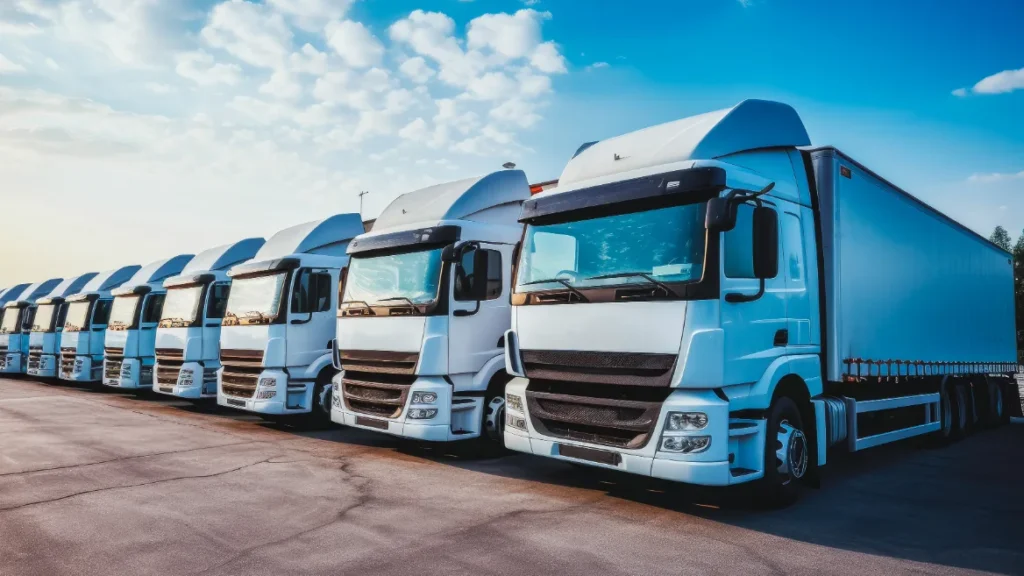
Buying a used HGV can be a smart way to grow your fleet — but only if you know what to look for.
Our latest guide covers every step, from checking emissions compliance and ownership records to calculating the true cost of ownership.
It also includes a post-purchase checklist and advice on avoiding common pitfalls, ensuring your next truck is reliable, compliant, and fit for the road ahead.
→ Get the complete used HGV buying guide.
⚡ A new EV charger every 33 minutes

The UK’s public EV charging network has expanded by 23% in the past year — the equivalent of one new charger every 33 minutes.
With over 86,000 chargers now available, the government and private sector are racing to keep up with demand from both drivers and fleets.
New planning reforms and major investments from ChargeUK, Vauxhall and Gridserve are ensuring access for renters, rural areas, and freight operators alike.
→ Read the full EV infrastructure update.
Also worth a read
- 🚛 Learn how to forecast demand, scale your fleet, and keep deliveries on track when seasonal peaks hit the road freight sector.
- 🧊 Cold storage moves underground as M&M Quality Solutions opens a subterranean logistics hub — reshaping the future of temperature-controlled freight.
- 🕵️♂️ What a $100m Louvre jewellery heist can teach the industry about preventing freight fraud and cargo theft.
- 🛡️ With freight crime soaring, experts say driver safety and secure parking must move to the top of the logistics agenda.
Find reliable carriers and cut your costs with Haulage Exchange
Sign upBuying a used HGV can be one of the smartest ways to grow your fleet without overspending. But with so many factors to consider – from emissions standards to ownership checks – it’s easy to make an expensive mistake.
In this guide, we’ll cover everything you need to know before you buy a second-hand HGV, from understanding your operational needs to calculating long-term costs.
What we’ll cover
Fleets, bookings, subcontractors, compliance & payments.
Book a demo
With HX, you can manage them all in one place.Buy new or second-hand – which is right for your business?
When it comes to expanding your fleet, deciding between a brand-new and a used HGV comes down to your priorities: cost, reliability, and flexibility.
Both have clear advantages — but also some trade-offs.
Buying a new HGV:
- Comes with a full manufacturer warranty and no prior wear.
- You’ll get access to a wider range of different lorry types.
- Meets the latest emissions and freight transport standards out of the box.
- Often includes telematics, safety tech, and low-emission compliance for cold chain transport and urban work.
- But you’ll pay a premium, wait longer for delivery, and face faster depreciation in the first few years.
Buying a used HGV:
- Much lower upfront cost, freeing cash for upgrades or extra drivers.
- Immediate availability — ideal for meeting new haulage contracts quickly.
- Easier to finance through finance or short-term leasing.
- May require checks on emissions, maintenance, and compliance to avoid future costs.
In short, buying new suits operators focused on long-term efficiency and minimal downtime. Buying a second-hand HGV suits those expanding fast or balancing cash flow.
1. Understand what you need before you buy
Before looking at vehicles, think about how your used HGV will be used day to day. The right choice depends on the type of work, routes, and loads you handle.
Things to consider:
- Operation type: Long-haul, regional, or last-mile deliveries.
- Body style: Rigid, tractor unit, or specialist vehicle such as a walking floor lorry.
- Payload and axle configuration: Match capacity to your contracts, not your ambitions.
- Fuel and emissions: Choose Euro VI to avoid daily ULEZ charges and lower HGV carbon emissions.
- Future-proofing: Consider compatibility with HVO fuel or hybrid systems.
Many buyers over-purchase – paying for capacity they rarely use. Focus on trucks that suit your routes and haulage contracts.

2. Check legal and identity documents
Before money changes hands, confirm the truck’s legal status and identity. A few quick checks can save you from disputes and hidden costs later.
Here’s what to check:
- VIN and registration: Cross-check on DVSA and HPI databases.
- MOT history: Look for consistent mileage and any recurring advisories.
- Finance and theft records: Use an HPI or NMR check to confirm the vehicle’s clear of outstanding finance.
- Imports: Confirm NOVA registration and a valid Certificate of Conformity or IVA approval.
- Ownership chain: Match the V5C with the seller’s business name and VAT status.
If you’re adding the truck to an operator’s licence, make sure it’s listed promptly to stay compliant with traffic commissioner requirements. Missing paperwork or gaps in history are warning signs.
3. Inspect the mechanical and technical condition
A used HGV that looks clean on the yard might still hide issues. A professional inspection is well worth the fee.
What to look for:
- Engine leaks or unusual smoke.
- Clutch wear and brake performance.
- Suspension and steering play.
- Corrosion on the chassis or cab.
- Tyre age (must be under 10 years on steering axles) and tread depth (minimum 1mm).
- Warning lights or diagnostic codes showing emission or DPF faults.
If possible, get an independent HGV mechanic to inspect the vehicle or run a full pre-purchase inspection. Ask for service records and brake test reports to confirm the truck’s been properly maintained.
You can also check that the truck meets DVSA annual test standards before completing the sale. A small cost upfront can save thousands in repairs later.
4. Stay compliant with UK and local standards
Regulations affect where and when you can operate a used HGV. Make sure the vehicle meets current and future requirements before you commit.
Emission and safety standards to check:
- ULEZ and Clean Air Zones: Vehicles must be Euro VI to avoid daily fees in cities like London, Birmingham, and Manchester.
- Direct Vision Standard (DVS): HGVs entering London need at least a 3-star rating or a Progressive Safe System retrofit.
- Weight and axle limits: Keep within legal limits for your configuration.
- Safety equipment: Cameras, conspicuity markings, and side guards might be mandatory in some areas.
Buying a cheaper, older truck can look like a saving, but the wrong emissions class can quickly eat into your profit through daily charges.
5. Calculate the total cost of ownership (TCO)
The sticker price only tells part of the story. To know the true cost of your used HGV, calculate its total cost of ownership over three to five years.
Cost Area What to Consider Fuel economy Compare Euro V vs Euro VI efficiency. Maintenance Check availability and price of spare parts. Insurance Factor in HGV insurance and risk profile. Telematics Integration with fleet management tools. Road tax Include annual HGV road tax costs. Resale value Euro VI trucks hold their value better. A slightly higher upfront price can mean lower running costs and downtime. Make sure you calculate everything before you commit.
6. Research the seller and buy with confidence
Not all sellers offer the same level of transparency. Whether you’re buying a used HGV from a dealer, auction, or private seller, trust and documentation matter.
Dealers and sellers:
- Franchised dealers: Usually offer warranties and service records.
- Independent traders: May have competitive prices but check documentation carefully.
- Fleet disposals: Often well-maintained and come with complete service histories.
Questions to ask:
- Can I see full service and repair records?
- Has the truck been used for light haulage or heavy work?
- Is the mileage consistent across MOT, tachograph, and service records?
- What’s the VAT and ownership status?
Use secure payment methods and always get a formal invoice for your used HGV. Avoid rushed transactions or pressure to pay deposits upfront.
What to do after buying a used HGV
Once the sale’s complete, a few administrative steps keep you on the road legally.
Post-purchase checklist:
- Transfer the V5C registration to your name or company.
- Add the vehicle to your operator’s licence.
- Set up HGV insurance and schedule routine maintenance.
- Pay HGV road tax and keep the receipt for records.
- Fit telematics or cameras to integrate with your yard management systems.
- If needed, refurbish the body, repaint the cab, or add safety features.
Some buyers also arrange HGV financing for upgrades for their used HGV, such as retrofitting camera systems or emissions controls.
Common buying mistakes to avoid
A few oversights can turn a good deal into a financial headache. Here are the mistakes to avoid when buying a used HGV:
- Not inspecting the vehicle in person.
- Failing to check emissions compliance before buying.
- Ignoring gaps in the service history.
- Buying without checking for outstanding finance.
- Forgetting to budget for the first maintenance cycle.
If the price seems too good to be true, it usually is.
Building a reliable, future-ready fleet
A well-chosen used HGV can serve your business for years. Think beyond today’s contracts and plan for long-term flexibility. Whether you’re just starting your haulage company, growing your operation, or specialising in niche freight, the right purchase supports your goals without overstretching your budget.
Used trucks play an important role in modern freight transport, helping operators balance costs while maintaining reliability. With the right approach, you can expand safely, reduce supply chain vulnerability, and strengthen your overall supply chain optimisation strategy.
And remember: the best truck isn’t just the one that’s cheapest today, but the one that fits your routes, haulage loads, and compliance obligations tomorrow.
Find reliable carriers and cut your costs with Haulage Exchange
Sign upFrequently asked questions
What’s the average mileage for a reliable used HGV?
Most operators look for trucks with under 500,000 miles, but mileage matters less than maintenance. A well-serviced high-mileage truck can outperform a neglected one.
Are used HGVs still subject to ULEZ or Clean Air Zone charges?
Yes. Unless they meet Euro VI standards, older trucks pay daily fees in most cities. Always check local authority websites before purchase.
Can I buy a used HGV through finance?
Yes. Many buyers use finance agreements to spread costs. Check interest rates, balloon payments, and ownership terms before committing.
What’s better for my business: a rigid or articulated truck?
It depends on your operation. Rigids suit regional and urban work, while tractor units offer flexibility for long-distance haulage contracts and different lorry types.
How can I reduce my running costs after buying?
Use telematics to track fuel use and schedule maintenance. Switching to HVO fuel where compatible can also reduce emissions and operating costs.
Welcome to This Week in Freight, your go-to source for the latest haulage and road freight news and advice in the UK.
Amazon’s at it again — this time with smart glasses for delivery drivers. Are they the next big leap for hands-free logistics, or just surveillance in disguise?
Meanwhile, the EU is tightening ADR inspections with new risk classifications that could change how carriers transport dangerous goods, and HVO fuel is taking centre stage as a cleaner, drop-in diesel alternative.
Also in this week’s round-up: AI that drivers actually want in their cabs, the safest new truck stop in the UK, and the Dutch cities leading Europe’s zero-emission freight revolution.
👓 Smart glasses for drivers?

Amazon’s new smart glasses promise safer, hands-free deliveries — projecting routes, parcel data and hazard alerts directly in drivers’ view.
But critics warn the tech could bring tighter targets and new levels of workplace surveillance.
As AI-powered wearables enter logistics, the line between innovation and intrusion is blurring.
→ See how Amazon’s pilot could reshape driver life.
🧯 EU steps up ADR safety checks
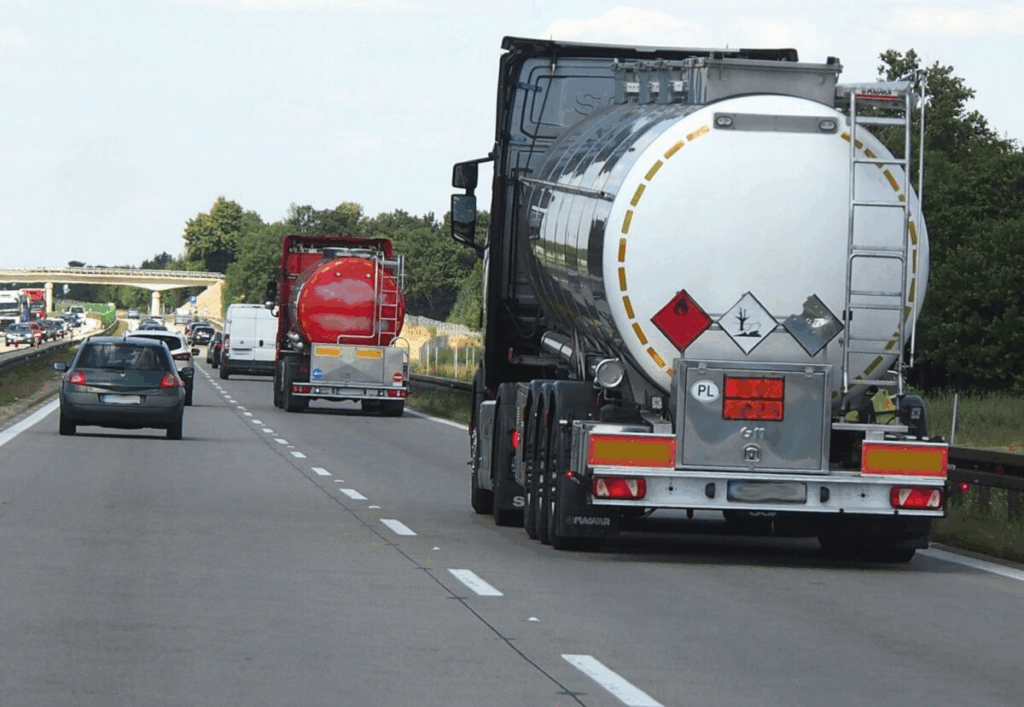
The EU has approved new ADR inspection rules introducing a unified checklist, tougher penalties, and shared responsibility across the supply chain.
From June 2026, hauliers, loaders, and even consignees must follow stricter documentation and training standards for dangerous goods.
→ Find out what the new directive means for your compliance plans.
🌱 HVO fuel powers the road to net zero
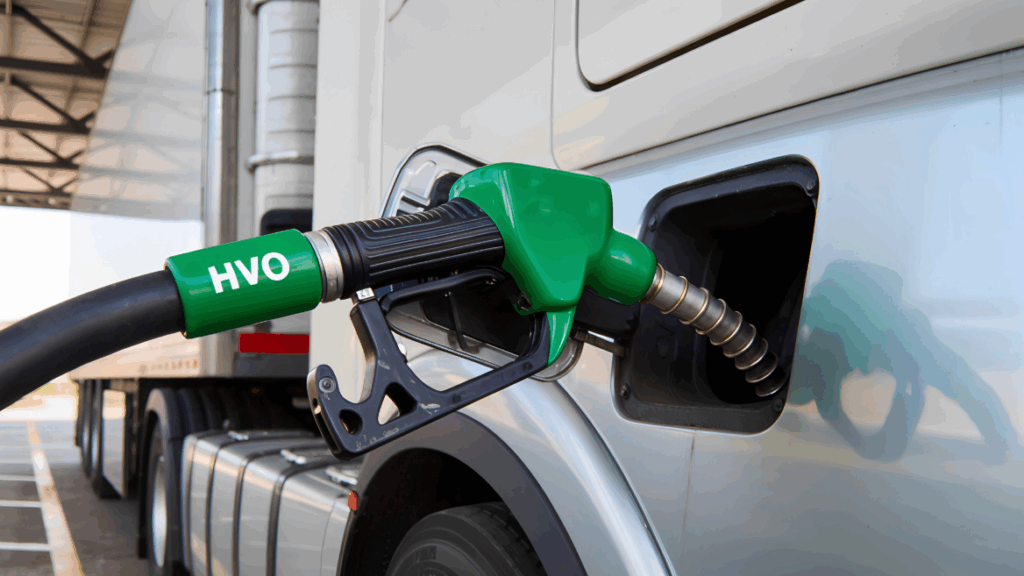
HVO fuel is gaining ground as a drop-in diesel alternative that cuts emissions by up to 90%.
Compatible with most modern HGVs, it offers fleets a quick, low-risk route to cleaner operations without new infrastructure.
With prices set to fall as production scales, it’s becoming a realistic step towards decarbonising UK haulage.
→ Get the complete guide to HVO fuel for your fleet.
Also worth a read
- 📡 ADAS tech is transforming HGV safety, helping drivers avoid fatigue, cut collisions and meet new EU safety standards.
- 💷 Fuel duty could rise again as experts warn the Autumn Budget may reverse the 5p cut and explore pay-per-mile road charges.
- 📱 LeShuttle Freight has launched a new Driver Companion app, keeping drivers informed, connected and rewarded throughout their journeys.
- 🛑 Sutterton truck stop in Lincolnshire has earned Park Mark Freight status, joining the UK’s safest and best-equipped sites for drivers.
- 🤖 Most UK truck drivers support AI in cabs — but only if video footage isn’t stored, highlighting the balance between safety and privacy.
Sustainability news
Here are this week’s big developments across road haulage sustainability:
- ⚡ DFDS has deployed the UK’s first government-backed electric HGV, marking a milestone for the ZenFreight consortium and the country’s zero-emission freight rollout.
- 🇳🇱 Dutch zero-emission zones are driving record EV adoption, with electric truck registrations up nearly 190% year on year as logistics firms embrace cleaner fleets.
- 💨 Biomethane deserves a bigger role in decarbonising haulage, according to a new industry report urging policy changes to extend fuel duty discounts and boost investment.
Find reliable carriers and cut your costs with Haulage Exchange
Sign upHaulage businesses across the UK are under pressure to cut emissions and move towards cleaner energy. Heavy goods vehicles are still largely diesel-powered, but that’s beginning to change. HVO fuel offers hauliers a simple way to reduce emissions without replacing their fleet or infrastructure.
In this guide, we’ll look at what HVO fuel is, how it works, and what it means for HGV fleets today.
What we’ll cover
Fleets, bookings, subcontractors, compliance & payments.
Book a demo
With HX, you can manage them all in one place.What is HVO fuel?
HVO fuel, short for hydrotreated or hydrogenated vegetable oil, is a renewable diesel alternative made from waste fats and vegetable oils. It’s part of a group known as paraffinic diesels, which are synthetically produced from renewable materials rather than crude oil.
Unlike traditional biodiesel, HVO fuel doesn’t contain fatty acid methyl esters (FAME). This makes it more stable, cleaner burning, and less prone to issues like oxidation or water contamination. Because it’s a “drop-in” fuel, operators can use it in existing diesel engines with no modifications.
You’ll also hear it called renewable diesel, green diesel, or HVO diesel, but they all refer to the same thing.
How HVO fuel is made
HVO fuel is produced through a process called hydrotreatment. Waste oils and animal fats are purified, then treated with hydrogen at high temperatures. This process removes oxygen and impurities, creating a high-quality hydrocarbon fuel almost identical to fossil diesel.
The hydrotreatment process includes two main stages:
- Pre-treatment: Feedstocks such as used cooking oil and animal fat waste are filtered and cleaned.
- Hydrotreatment and isomerisation: Hydrogen reacts with the oils to form pure hydrocarbons that mimic diesel in structure and performance.
Because the process is tightly controlled, the result is a consistent, clean, and stable fuel. HVO can be stored for up to 10 years, compared to around one year for regular diesel.
HVO vs biodiesel vs fossil diesel
Property Fossil diesel Biodiesel (FAME) HVO fuel Feedstock Crude oil Vegetable/animal fats Waste oils & fats Stability 1 year Poor Up to 10 years Cetane number ~51 50–65 70–90 Emissions High CO₂ & NOx Moderate Up to 90% CO₂ reduction Compatibility Full Limited blends 100% drop-in Cold weather performance Average Poor Excellent (-27°C CFFP) While biodiesel can only be blended in small percentages, HVO can replace diesel entirely. It burns more cleanly, gives better cold starts, and resists degradation in storage.
Environmental and performance benefits of HVO fuel for haulage
For the haulage industry, HVO fuel offers a rare combination of cleaner emissions, improved reliability, and straightforward adoption. It helps fleets meet sustainability goals without sacrificing performance or uptime.
HVO for haulage is a genuine drop-in fuel — it can be used immediately in most existing diesel engines with no mechanical modifications or new infrastructure. Major manufacturers such as DAF, Volvo, Scania, MAN, Mercedes-Benz, Iveco, and Renault Trucks have approved its use, alongside equipment makers like Caterpillar and John Deere.
This compatibility makes it a practical, low-risk switch for fleets that want to cut emissions quickly while keeping operations running as normal.
When used as a full replacement for diesel, HVO can cut lifecycle CO₂ emissions by up to 90%. These reductions come from its renewable origins and the cleaner way it burns inside engines. It’s also free from sulphur, aromatics, and FAME, which makes it far more stable than conventional fuels.
1. Cleaner emissions and sustainability gains
HVO releases far fewer pollutants than fossil diesel, producing lower levels of nitrogen oxide (NOx), particulate matter (PM), and carbon monoxide (CO). These reductions help improve air quality, particularly in cities and logistics hubs where HGVs often operate.
Because it’s made from waste oils, fats, and residues, HVO supports a circular approach to fuel production. Every litre reused helps divert waste from landfill or incineration, making it a strong fit for circular economy logistics models.
For haulage operators working under emissions reporting frameworks or haulage contracts that require sustainability metrics, these measurable carbon savings can make a real difference. The fuel’s performance has also been independently verified under the Renewable Transport Fuel Obligation (RTFO), reinforcing its role in helping businesses transition to lower-carbon operations.
2. Reliable performance and engine health
HVO isn’t just about lowering emissions. Its high cetane number, usually between 70 and 90, provides faster ignition and more complete combustion. That leads to quieter operation, improved fuel efficiency, and less engine wear over time.
Because it burns cleaner and contains no FAME, there’s less soot formation and injector fouling, meaning longer service intervals and fewer maintenance callouts. Fleets that switch to HVO often report cleaner filters and lower emissions test readings, even under heavy use.
3. Cold weather stability and storage life
For operators storing bulk fuel at depots, reliability in all conditions is critical. HVO maintains consistent performance in cold weather, with a Cold Filter Plugging Point (CFFP) as low as -27°C. This means trucks can operate efficiently throughout the winter without waxing or fuel flow issues.
Another major advantage is HVO’s storage stability. While mineral diesel begins to degrade after a year, HVO can be stored safely for up to 10 years with minimal risk of oxidation or microbial growth. This makes it ideal for large depots, standby generators, and seasonal operations.
Add to that its non-toxic and biodegradable nature, and you’ve got a renewable fuel that’s both safer to handle and easier to manage long term.

Cost and availability
Right now, HVO fuel costs around 10–15% more than standard diesel. Prices vary by supplier and region, mainly due to feedstock costs and limited UK production capacity.
Despite this, many hauliers see the higher cost as a trade-off for long-term savings. HVO helps fleets stay compliant with emissions regulations and can lower costs tied to maintenance and carbon reporting.
UK suppliers such as Crown Oil, Prema Energy, and Your NRG distribute HVO nationwide, though supply can be limited in rural areas. Over time, as production expands, prices are expected to narrow.
Supply and sourcing in the UK
The UK’s growing demand for renewable diesel has outpaced local production. At present, most HVO for haulage is imported from large-scale European producers like Neste, where it’s refined using waste oils and animal fats. Once processed, it’s distributed to UK suppliers who manage regional delivery networks.
Feedstocks used to make HVO include used cooking oils, tallow, and vegetable residues, all of which would otherwise become waste. These materials are cleaned, treated, and refined into a consistent, paraffinic diesel with the same energy density as standard fuel.
Because the availability of these feedstocks depends on agricultural and food industry output, prices can fluctuate. Seasonal shifts in supply and competition from other sectors also influence wholesale cost. As more waste-derived inputs and refining capacity come online, these costs are expected to stabilise.
Certification and fuel quality
To verify that HVO fuel is sustainable and responsibly sourced, hauliers should look for certification from schemes like ISCC (International Sustainability & Carbon Certification) or RFAS (Renewable Fuel Assurance Scheme). These certifications confirm that the fuel is:
- Derived from traceable, waste-based feedstocks rather than palm oil.
- Verified for greenhouse gas reductions across its full lifecycle.
- Fully compliant with the UK’s Renewable Transport Fuel Obligation (RTFO).
Most certified suppliers provide a Proof of Sustainability (POS) document, which details the origin and production route of each batch.
Choosing certified HVO protects businesses from reputational risks and supports genuine carbon reduction efforts.
Choosing the right supplier
For hauliers planning a transition to renewable fuel, supplier choice matters. When sourcing HVO, it’s worth checking:
- Whether the product is ISCC- or RFAS-approved and palm-free.
- If the supplier can offer consistent volumes across multiple depots.
- Lead times for bulk orders and whether prices are fixed or indexed.
- Blending options, in case you plan to phase adoption gradually.
Because HVO has a long storage life, some operators choose to buy in bulk when prices are favourable. This approach also minimises delivery emissions and administrative time.
Understanding where your HVO fuel comes from not only helps control costs but also reinforces your business’s environmental commitment. In an industry where traceability and compliance are becoming central to tendering and haulage contracts, sourcing the right supplier can make a measurable difference.
Challenges and considerations
While HVO for haulage is one of the most promising low-carbon fuels available, there are challenges.
- Availability: Distribution networks are still expanding, so not all regions have consistent supply.
- Feedstock sourcing: Quality can vary depending on supplier, especially if non-certified palm oil is used.
- Certification: Look for ISCC or RFAS certification to confirm waste-derived origins.
- Cost: Still higher than diesel, though this gap is closing.
HVO isn’t completely carbon neutral. Emissions vary depending on how it’s made and transported, but it’s a major step towards decarbonisation while maintaining performance.
HVO vs electric vehicles for haulage
Electric trucks are often seen as the long-term solution for road transport, but they’re not yet practical for every operation. HVO fuel offers an immediate alternative that works with existing diesel fleets.
Electric HGVs require new infrastructure, higher upfront costs, and more downtime for charging. HVO can be used today with no major changes, making it an ideal transitional fuel while electrification develops.
Many operators now use a mix of both—electric for urban deliveries and HVO for long-haul routes where range and payload matter.
Regulations and the future of renewable fuels
Government initiatives like the Renewable Transport Fuel Obligation (RTFO) are pushing UK businesses to adopt low-carbon fuels. As part of the move toward net zero, liquid fuels like HVO are gaining traction in the haulage and logistics sectors.
Many fleets also face new reporting pressures under Scope 3 emissions standards. Switching to renewable fuels supports those sustainability metrics while maintaining performance and reliability.
Over the next decade, the UK is expected to expand on-road access for HVO, especially for commercial transport. More suppliers are entering the market, and growing investment in renewable production means better supply and pricing in the near future.
How to switch to HVO fuel
Switching to HVO is straightforward. Here’s how hauliers can do it:
- Check your engine manufacturer’s approval list for HVO compatibility.
- Choose a certified, palm-free HVO supplier.
- Clean existing diesel tanks if switching entirely to avoid residue contamination.
- Consider a blended approach initially (e.g. 20–50%) before moving to 100%.
- Track fuel usage and emission savings for reporting.
There’s no downtime or complex installation. You can simply fuel up and go.
The road ahead for haulage
HVO isn’t just a greener alternative—it’s a practical way to keep your business compliant, efficient, and future-ready. It gives operators a bridge between today’s diesel fleets and tomorrow’s zero-emission technology.
As government targets tighten and customer expectations shift, hauliers using HVO fuel can show real progress on sustainability without disrupting operations.
From long-haul freight to haulage return loads, HVO provides flexibility, reliability, and a clear route to cleaner transport.
Find reliable carriers and cut your costs with Haulage Exchange
Sign upFrequently asked questions
Can I use HVO fuel in any diesel engine?
Yes. Most modern diesel engines are compatible with HVO, but it’s always worth checking the manufacturer’s guidance.
Is HVO available at UK fuel stations?
Public access is limited, but it’s widely available through commercial suppliers in bulk quantities.
Does HVO affect fuel economy?
Performance and fuel economy are very similar to fossil diesel, often with smoother combustion and less noise.
Is HVO better for the environment than biodiesel?
Yes. It produces lower emissions and is more stable, so it stores better and performs consistently.
Can HVO be mixed with diesel?
Yes. It can be blended in any ratio, although you’ll see the biggest benefits from using pure HVO (HVO100).
Modern ADAS systems are transforming how drivers and fleet operators manage safety on the road. Once seen as optional extras, these technologies are fast becoming standard in heavy goods vehicles.
For an industry where safety, efficiency, and reliability matter, advanced driver assistance systems are changing the way we drive, manage, and maintain fleets.
What we’ll cover
Fleets, bookings, subcontractors, compliance & payments.
Book a demo
With HX, you can manage them all in one place.What is ADAS?
ADAS technology combines sensors, cameras, radar, and onboard software to monitor surroundings and support drivers in real time. It doesn’t replace human judgement, but it provides an extra layer of awareness that helps prevent accidents and improve comfort on long routes.
Here’s a quick look at how the main features work:
ADAS Feature What It Does Why It Matters for HGVs Adaptive cruise control (ACC) Adjusts speed to maintain a safe distance Reduces fatigue and rear-end collisions Lane departure warning (LDW) Alerts the driver if the truck drifts Helps avoid lane drift and side swipes Automatic emergency braking (AEB) Brakes automatically if a collision is likely Prevents or reduces crash severity Blind spot detection (BSD) Monitors blind spots using radar or cameras Reduces risk during lane changes Driver fatigue monitoring Detects drowsiness or distraction Warns drivers to take a break These systems use the same foundation as ADAS calibration tools, which align sensors and cameras to maintain accuracy. Together, they create an integrated safety net that benefits both drivers and operators.
How ADAS improves safety and efficiency
Every HGV driver knows how demanding long-distance driving can be. Fatigue, limited visibility, and unpredictable road users all raise the chance of an accident. ADAS technology supports safer driving by spotting hazards sooner than the human eye.
Automatic braking, adaptive cruise control, and lane assistance all help reduce reaction times. In practice, this means fewer rear-end collisions and side impacts. Many fleet operators also report lower fuel use thanks to smoother acceleration and fewer hard-brake events.
For drivers, this technology makes long routes less tiring. Alerts for lane drift or fatigue reduce pressure, especially during overnight deliveries or when handling high-risk freight. The result is a safer and calmer driving experience.
ADAS for fleet managers
For fleet managers, the benefits go beyond road safety.
Connected ADAS systems provide real-time data that can help with maintenance schedules, HGV insurance reporting, and compliance checks.
Benefit Impact Fewer accidents Reduced repair costs and downtime Telematics integration Better visibility and data accuracy Lower maintenance Less strain on tyres and brakes Improved compliance Supports GSR2 safety standards and DVSA fleet inspections Training support Identifies where drivers may need more guidance Integrating ADAS systems into your wider yard management systems also improves coordination. When vehicles communicate status updates automatically, your dispatchers can plan around issues faster and avoid complications with your contracts.
The importance of ADAS calibration
ADAS calibration keeps the system working properly after repairs, windscreen replacements, or wheel alignments. Calibration means adjusting cameras, sensors, and radar units so that they can read distances and surroundings accurately.
If calibration is off, even by a small margin, the system may misjudge obstacles or fail to trigger a warning in time. That’s why it’s recommended to include calibration checks in regular HGV maintenance.
Correct calibration also supports compliance with UK and EU tachograph rules, since the data from ADAS sensors often integrates with digital reporting systems. Keeping those aligned means more accurate logs, better safety checks, and fewer problems during fleet inspections.
Challenges and misconceptions
Despite the benefits, adoption across the haulage industry still varies. Smaller operators may see ADAS as expensive to install or maintain, especially for older haulage vehicles.
Yet, the cost of an accident or extended downtime often outweighs the upfront investment.
Training is another hurdle. Drivers need time to understand how different alerts and interventions work. That’s where driver CPC training can help by introducing ADAS use into safety modules.
There’s also a concern about over-reliance on the system. Drivers must stay alert and remember that ADAS assists rather than replaces their attention. The most effective fleets combine technology with driver awareness, not one without the other.
Regulations and the future of HGV safety
European and UK safety standards are pushing the industry forward. Under the EU’s General Safety Regulation (GSR2), several ADAS systems—including lane keeping and automatic braking—are now mandatory on new vehicles. The UK has adopted similar standards, creating consistency for international fleets.
This move aligns with wider efforts to reduce collisions involving longer heavier vehicles (LHVs) and improve overall freight safety. For operators, compliance isn’t just about ticking boxes. It’s about staying ahead as the transport sector evolves toward automation and smarter logistics.
In the near future, we’ll see more connected ADAS technology that links vehicles, depots, and infrastructure. Combined with secure truck parking and live telematics, it’ll allow safer rest planning and better use of periods of availability.
These changes will support sustainability targets too, by cutting idle time and improving routing efficiency.
ADAS and the bigger picture
The development of ADAS systems sits at the heart of the shift toward autonomous driving. But it’s not about removing drivers from the cab. It’s about giving them better tools to make informed, confident decisions.
Safer fleets mean fewer accidents, reduced downtime, and better delivery reliability. For an operator, that also improves the business case when competing for haulage contracts.
For the wider sector, ADAS could play a major role in tackling issues like driver shortages, insurance costs, and HGV speed restrictions. Every alert, sensor, and automated assist helps keep drivers safer, freight more secure, and roads less congested.
Final thoughts
Modern ADAS technology is reshaping how HGV fleets operate. For drivers, it brings safety, comfort, and confidence on the road. For fleet managers, it offers valuable insight into performance, compliance, and efficiency.
The future of haulage isn’t autonomous—it’s assisted. Systems that detect, alert, and support drivers are the next step in building smarter, safer logistics networks.
As adoption grows, those who invest early will not only reduce accidents but also gain a strong advantage in both safety standards and customer trust.
Find reliable carriers and cut your costs with Haulage Exchange
Sign upFrequently asked questions
What does ADAS mean on a truck?
ADAS stands for Advanced Driver Assistance Systems. It refers to electronic safety features such as adaptive cruise control, lane departure warnings, and automatic braking that help drivers avoid accidents.
Do all HGVs need ADAS?
Not yet, but most new models include it as standard. UK and EU safety regulations are gradually making ADAS features mandatory on new HGVs.
How often should ADAS calibration be done?
You should calibrate sensors whenever the windscreen, wheels, or bumpers are replaced, or after any accident. Regular checks are also recommended as part of standard maintenance.
Can ADAS reduce insurance costs?
Yes. Many insurers offer discounts for vehicles equipped with ADAS because they lower accident rates and repair costs.
Is ADAS the same as autonomous driving?
No. ADAS supports the driver but doesn’t replace them. It provides alerts and automatic responses to improve safety while keeping the driver in full control.
Welcome to This Week in Freight, your go-to source for the latest haulage and road freight news and advice in the UK.
Freight thefts are surging across the UK — but hauliers are pushing back. A new alliance between Logistics UK and TAPA EMEA aims to share intelligence and strengthen defences before criminals strike again.
We also take a look at how operators are upgrading fleets without draining cash reserves, with a deep dive into the best HGV finance and leasing options available today.
Meanwhile, in Europe, a German haulier’s decision to install full bathrooms in its cabs has sparked debate: can comfort perks really fix a driver shortage rooted in pay and conditions?
Plus, we round up the latest in EV freight trials, new logistics hubs, hydrogen innovation, and charging breakthroughs across the UK and Europe.
🛡️ British hauliers unite against freight crime

Freight thefts cost the UK nearly £700m a year — and hauliers are fighting back.
Logistics UK and TAPA EMEA have formed a new alliance to share intelligence, raise security standards and protect drivers.
The partnership builds on wider efforts to improve safety, including links with NAVCIS and Motorway Buddy. It’s a united front for safer roads and more secure loads.
→ Read how the industry is joining forces.
💰 How to fund your next fleet upgrade

Replacing ageing HGVs can drain capital fast — but smart financing could ease the strain.
From leasing and hire purchase to sale-and-leaseback, our new guide breaks down the main funding options for hauliers looking to modernise their fleets, including:
- How each financing model works
- What to check before signing
- How greener finance options support electric and hybrid trucks.
→ Explore which HGV finance option fits your business.
🚛 Onboard bathrooms: fix or gimmick?
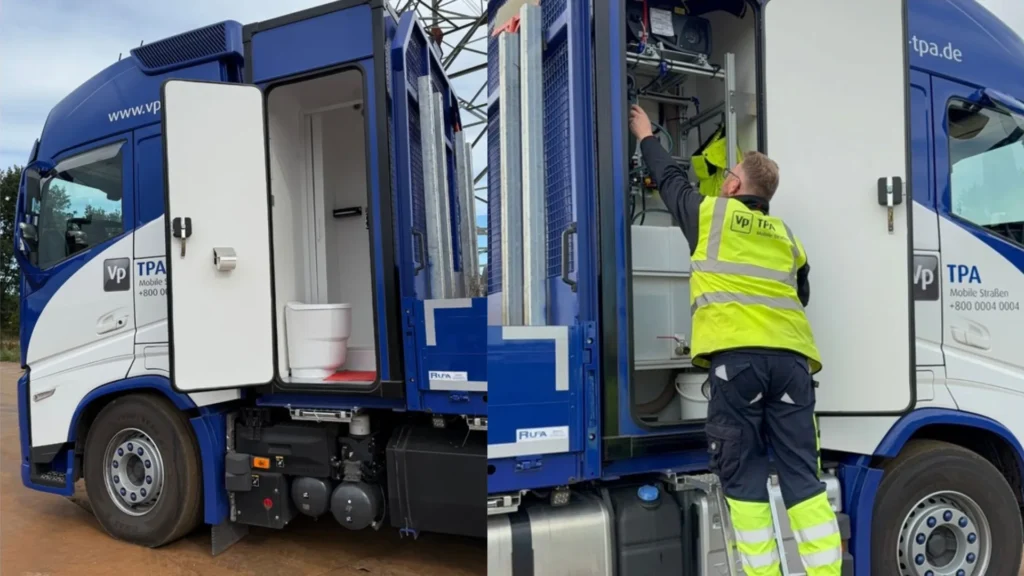
A German haulier has fitted its trucks with full bathrooms — shower, toilet, and all — as Europe faces 426,000 unfilled driver roles.
But critics say no amount of comfort can fix deeper issues like low pay, long hours and poor facilities.
Across Europe, firms are testing everything from housing support to fixed shifts to make driving more attractive.
→ See which perks actually make a difference.
Also worth a read
- ⚡ Electric courier vans are improving fast — but are they truly ready for long routes and heavy loads?
- 🚛 A major UK eHGV trial has clocked over half a million zero-emission miles, proving electric trucks can already compete on cost and reliability.
- 🌍 Global supply chains are being reshaped by geopolitics as Western economies rethink their dependence on China.
- 🔋 Renault Trucks has mapped nearly 500 public charging stations for electric HGVs across Europe, showing progress but exposing how far infrastructure still has to go.
- ❄️ Everything you need to know about cold chain logistics — from temperature control and tracking to the tech keeping food and pharma freight fresh.
Movers & shakers
Here are this week’s big developments across road haulage:
- 🔋 Bosch has deployed a 40-tonne Iveco hydrogen truck at its Nuremberg plant to test real-world performance of its in-house fuel cell power module.
- 🍺 Britain’s oldest brewer, Shepherd Neame, has partnered with GXO and Renault Trucks to roll out new eHGVs as part of the Electric Freightway project.
- 📦 Carousel Logistics has launched a UK and Ireland PUDO network, giving engineers and field staff faster, label-free parts collection and returns.
- ⚙️ Voltempo has started series production of its HGV HyperCharger in Birmingham — the UK’s first megawatt charging system built for electric trucks.
Find reliable carriers and cut your costs with Haulage Exchange
Sign upKeeping a fleet of HGVs modern and compliant isn’t cheap. Between new emissions standards, fuel costs and maintenance, replacing ageing trucks can drain cash reserves quickly.
That’s why many operators are turning to HGV finance and leasing options to fund replacements more strategically.
In this guide, we’ll explain how HGV and truck financing models work in the UK, what they cost, and what to consider before signing. Whether you run five vehicles or fifty, choosing the right finance structure can help you stay competitive, compliant and cash-flow-positive.
What we’ll cover
Fleets, bookings, subcontractors, compliance & payments.
Book a demo
With HX, you can manage them all in one place.Why fleet replacement planning matters
Replacing trucks on time isn’t just about avoiding breakdowns. It’s about protecting your bottom line and your reputation.
Older trucks cost more to maintain, burn more fuel and often fall short of new emissions requirements. With HGV road tax and low-emission zones adding pressure, keeping older vehicles can quickly become uneconomical.
A structured replacement plan also helps with driver satisfaction and reliability. Drivers prefer modern vehicles with better comfort, safety and fuel efficiency. For operators, that means fewer missed haulage contracts, less downtime, and smoother operations across your business.
The challenge is finding a way to fund those replacements without tying up large amounts of capital. That’s where HGV finance and lorry leasing come in.
The main types of HGV finance and lorry leasing
There are several ways to fund new trucks depending on whether you want ownership, flexibility or predictable monthly costs. Below are the four most common HGV finance and HGV leasing options, explained in plain terms.
Operating lease or contract hire
An operating lease, sometimes called contract hire, is the most common choice for fleet operators. You pay a fixed monthly amount to use the truck for an agreed term, usually three to seven years. When the contract ends, you return the vehicle.
- The finance company owns the truck and carries the resale risk.
- Maintenance and servicing are often included.
- You don’t need to pay a deposit or worry about depreciation.
- It’s ideal for keeping fleets modern and predictable.
- Be mindful of mileage limits and return conditions, as extra charges may apply.
This form of HGV leasing suits operators who prefer low risk and regular vehicle updates.
Finance lease or lease purchase
A truck lease of this type works slightly differently. You still pay monthly instalments, but you have more flexibility at the end. You can extend the lease, share the resale value, or buy the vehicle outright.
- Ownership can transfer to you once final payments are made.
- You share some of the residual value risk with the finance provider.
- It offers more control than contract hire but higher payments.
- Useful if you plan to keep vehicles longer.
It bridges the gap between leasing and outright ownership, giving flexibility without a large upfront cost.
Hire purchase (HP)
Hire purchase is the simplest form of HGV finance for operators who eventually want full ownership. You pay a deposit, then regular monthly payments until the final instalment transfers ownership to you.
- You own the truck outright at the end of the term.
- The vehicle appears as an asset on your balance sheet.
- You handle maintenance, HGV insurance, and resale value.
- A higher deposit or interest rate may apply compared to leasing.
Hire purchase works well if you want long-term control of your assets rather than regular upgrades.
Sale and leaseback
If you already own vehicles, a sale and leaseback deal can free up working capital. You sell your used HGVs to a finance provider and lease them back or lease new replacements.
- The finance company owns the assets after purchase.
- You continue using the vehicles under a lease agreement.
- This structure improves liquidity while keeping operations running.
- Long-term costs can be higher, so contracts should be reviewed carefully.
For many haulage businesses, this is a quick way to raise funds while keeping your haulage loads moving.

Typical terms, costs and contract structures
Most HGV finance and leasing agreements run between three and seven years. The term length affects your monthly payments and residual value.
Finance providers calculate costs based on:
- The expected resale value of the truck at the end of the term.
- Annual mileage or usage limits.
- Maintenance options (included or excluded).
- Credit rating and deposit.
A shorter term usually means higher payments but newer vehicles more often. Longer terms reduce monthly costs but increase maintenance risk.
Many leasing plans allow for maintenance packages, covering servicing, tyres and inspections. This can simplify budgeting and keep uptime high across haulage and logistics operations.
Another advantage: lease payments are typically treated as operating expenses and may be tax deductible, making HGV finance an attractive option for managing cash flow.
What to consider before signing a finance or leasing deal
Before signing any HGV leasing or finance agreement, it’s worth checking a few details carefully.
- Residual value risk: Confirm who carries the risk if resale prices fall.
- Mileage limits: Check the annual allowance. Going over can lead to penalties.
- Maintenance coverage: Know what’s included and what isn’t.
- Early termination clauses: Look at the cost of returning vehicles early or upgrading mid-term.
- Accounting treatment: Leasing can affect how assets appear on your balance sheet.
- Flexibility: Ask if you can replace or upgrade to electric models mid-contract.
- Credit terms: Smaller firms may need a guarantor or pay higher interest.
Regulations also change quickly. Clean Air Zones, low-emission requirements and initiatives around reducing carbon emissions mean operators need flexible agreements that won’t trap them in diesel-only contracts.
It’s also smart to think about operational details, like yard management and vehicle uptime, to see how new lease terms fit your workflow.
When to replace your HGVs and how to plan it
Knowing when to replace a truck isn’t an exact science, but there are common indicators.
- Repair costs start rising faster than depreciation savings.
- Fuel efficiency drops.
- Vehicle downtime increases.
- Regulatory compliance becomes harder to maintain.
Many operators replace haulage vehicles every five to seven years, depending on mileage. If you cover long distances or run bulk transport operations, replacements might happen sooner.
With leasing or contract hire, you can build these replacement cycles into the contract, creating a predictable schedule that fits your workload. That way, you keep your fleet efficient without surprise costs.
The shift toward greener fleets and alternative finance options
The haulage sector is moving towards cleaner transport. Financing is adapting too.
Providers now offer HGV financing options that support electric, hybrid and biofuel trucks. These agreements can include grants, extended terms or upgrade clauses for low-emission vehicles.
Electric trucks have higher upfront costs, but finance models make them accessible without heavy capital outlay. Some providers also include infrastructure support, such as depot charging finance, which ties into the rise of longer heavier vehicles (LHVs) and zero-emission freight initiatives.
Operators focusing on sustainability should look for finance that allows technology updates, so they can switch to cleaner options without major penalties. Over time, greener fleets help cut costs and support carbon emissions targets.
The benefits of leasing for cash flow and risk management
Leasing gives operators access to new vehicles while keeping finances stable.
- No large upfront investment.
- Predictable monthly costs.
- Less exposure to depreciation and resale risk.
- Easier budgeting for maintenance and replacement cycles.
By spreading payments, you keep cash free for other priorities—like staffing, technology or upgrading your TMS and telematics systems. Leasing also makes it easier to grow your fleet gradually instead of taking on heavy debt.
For many hauliers, this flexibility is the difference between staying reactive and planning ahead confidently.
How to choose the right HGV finance provider
Not all finance providers understand haulage operations. The best ones tailor agreements around real-world usage and compliance requirements.
When comparing offers, look for:
- Experience working with HGV fleets.
- Transparent pricing and no hidden end-of-term fees.
- Maintenance options suited to your operating schedule.
- Advanced driver assistance systems (ADAS) included by default.
- Upgrade or early-return flexibility.
- Responsive customer service and support.
It’s also worth checking if the provider handles multiple vehicle types, from different types of lorries to trailers and even courier van leasing options.
That can make long-term fleet planning easier if your business covers multiple transport categories like cold chain logistics or general haulage.
Summary: Why you should cosnider HGV finance
Modern fleets can’t stand still. HGV financing gives you the flexibility to replace vehicles regularly, control cash flow and plan ahead for cleaner transport.
With the right leasing or hire purchase deal, you can stay compliant, manage costs and upgrade without draining capital.
Replacing trucks strategically isn’t just about cost—it’s about keeping your business reliable, efficient and ready for the next shift in transport technology.
Find reliable carriers and cut your costs with Haulage Exchange
Sign upFrequently asked questions
What’s the difference between HGV finance and leasing?
Leasing means you pay to use a truck for a set period, then return it at the end. Finance, such as hire purchase, lets you buy the truck over time and own it when payments finish.
Can I get finance for used HGVs?
Yes. Many finance providers offer used truck finance with flexible terms, though the rates and conditions may differ from new models.
How long are typical HGV leases?
Most truck finance and leasing agreements last between three and seven years, depending on mileage and vehicle type.
Can I lease specialist vehicles like refrigerated trucks?
Yes. Finance and leasing providers offer solutions for specialised vehicles used in cold chain logistics and bulk transport, often with custom maintenance packages.
Welcome to This Week in Freight, your go-to source for the latest haulage and road freight news and advice in the UK.
Electric is the word this week. The UK’s new depot charging grant scheme is giving hauliers a real boost toward electrification — covering up to 75% of installation costs and helping operators future-proof their depots.
At the same time, electric van sales hit a record high in September, rising 41% year-on-year despite wider market dips.
But it’s not all smooth driving: across Europe, tolls have now overtaken fuel as the biggest operational cost for hauliers.
Plus, you’ll find the latest on Italy’s delay compensation rules, new low-carbon tech pilots and major logistics investments shaping the road ahead.
⚡ Depot grants to power HGV electrification
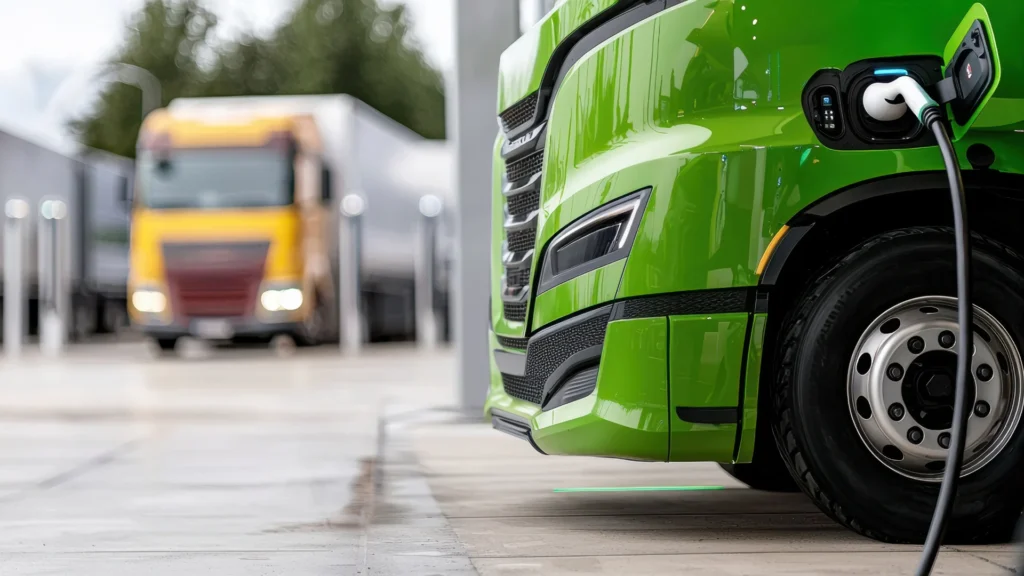
For years, fleet electrification has felt out of reach — complex, expensive, and uncertain. That’s changing fast.
The government’s new HGV depot charging grant is giving logistics operators the financial backing they need to build the infrastructure of the future.
From feasibility studies to full installations, funding is now live.
→ Find out how to apply and what you can claim.
🚚 Electric van sales hit record high

Electric van registrations surged 41% in September, reaching 4,262 units — the highest ever in a single month.
Despite an overall 2% dip in LCV sales, demand for electric and large vans is accelerating fast. With more than 40 models now on the market, manufacturers say the challenge is no longer choice, but charging.
SMMT warns that the UK’s 2025 targets will hinge on access to reliable infrastructure.
→ See what’s driving the surge — and what’s holding it back.
💶 Tolls now top fuel costs across Europe

The International Road Transport Union says tolls have overtaken fuel as the biggest expense for hauliers in parts of Europe.
In Germany, Austria and Hungary, per-kilometre tolls now exceed diesel costs — and new CO₂ surcharges under the Eurovignette Directive are widening the gap.
While diesel prices have stabilised, environmental levies and national taxes are reshaping profitability, pushing fleets toward zero-emission vehicles.
→ Read the full IRU analysis and see the cost breakdown.
Also worth a read
- 🇪🇺 The EU will extend its toll exemption for zero-emission trucks to 2031 to speed up electric HGV adoption.
- 📏 Longer and heavier vehicle (LHV) trials across Europe are testing whether efficiency can outweigh safety concerns.
- 🔋 UK hauliers can now lock in long-term fuel price certainty through a new fixed-price Bio-CNG supply deal.
- ⏱️ Italian hauliers are demanding strict enforcement of the new €100-per-hour delay compensation rule.
- 🚛 New flexible payment options are making HGV driver training more accessible to tackle driver shortages.
- 🚲 The city of Winchester is going to trial a city centre parcel hub using e-cargo bikes for last-mile deliveries under a £28.8m DfT scheme.
Movers & shakers
Here are this week’s big developments across road haulage:
- 🏗️ Pall-Ex has secured approval for an £80m national HQ and flagship hub in Leicestershire — a carbon-neutral “Centre of Excellence” set to create over 500 jobs.
- 📦 Raben Group will sell its Polish and German forwarding operations to Danish logistics firm Leman as it shifts focus entirely to contract logistics.
- 🤝 DX Group has opened two new DX-2 Super Sites in Birstall and Wellingborough to boost capacity and cut stem mileage across its two-person delivery network.
- ☀️ DHL Freight Sweden and Green Energy Group are piloting solar panels on HVO and biogas trucks to test fuel-saving performance across varied weather conditions.
Find reliable carriers and cut your costs with Haulage Exchange
Sign up
Add-ons
Support
About
2000 - 2025. Transport Exchange Group Ltd, Reg No. 3464353 © E&OE